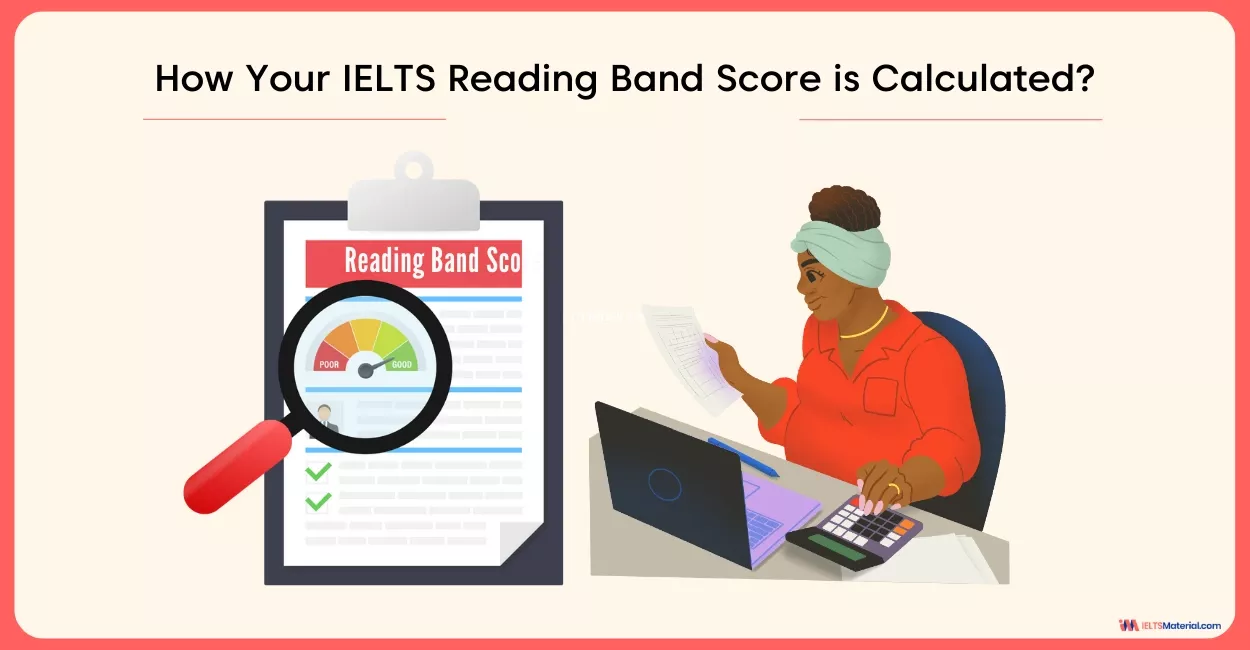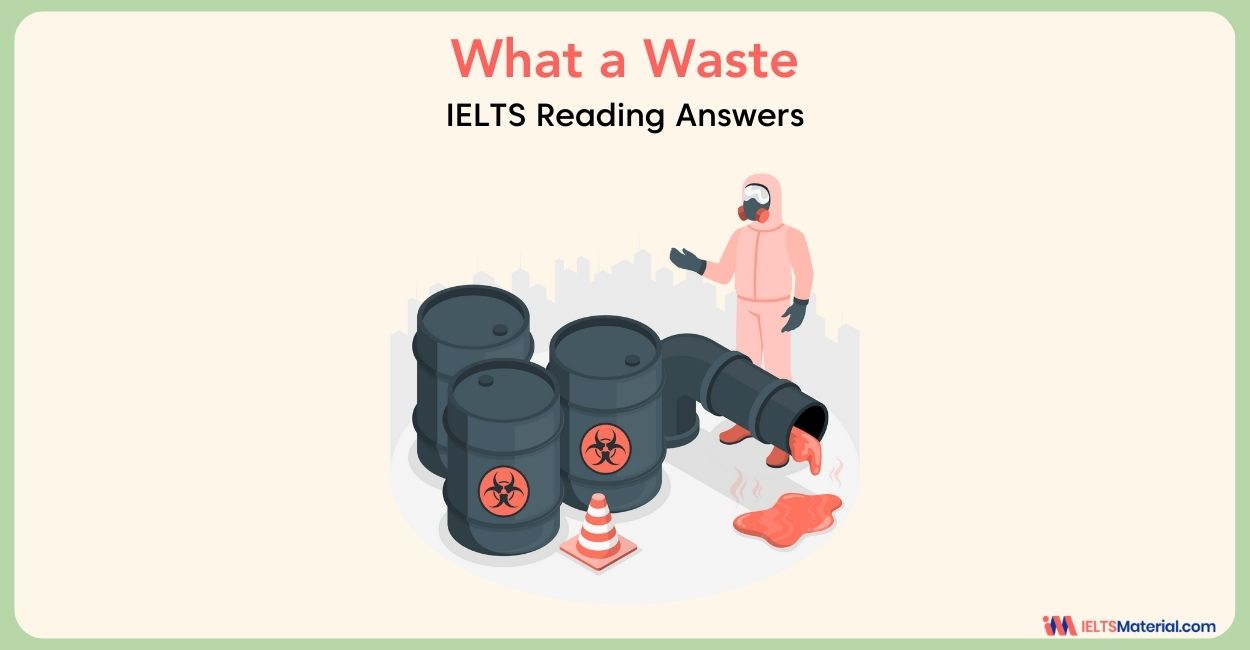What a Waste IELTS Reading Answers
14 min read
Updated On
-
Copy link
Want to boost your IELTS Reading score fast? Explore detailed answer explanations and smart tips for each question type in our breakdown of What a Waste IELTS Reading Answers and master them all with confidence!
Table of Contents

Limited-Time Offer : Access a FREE 10-Day IELTS Study Plan!
What a Waste IELTS Reading Answers is an IELTS Academic Reading passage that includes 14 questions aimed at testing a variety of reading skills. With regular practice, the Reading module can become the highest-scoring section for IELTS aspirants. The key to success lies in mastering the different question types.
By solving sample questions from actual IELTS Reading papers, you can refine your strategy and improve accuracy. This passage features the following question types:
- Matching Features (Q.1 – Q.4)
- Multiple Choice Questions (Q.5 – Q.6)
- Summary Completion (Q.7 – Q.14)
Aiming for a Band 9 in IELTS Reading? Watch the video below for expert tips and proven techniques!
What a Waste IELTS Reading Passage
| You should spend about 20 minutes on the Reading Passage below. |
Every day, all over the world, unwanted waste is disposed of from both domestic and commercial sources, usually with insufficient attention paid to the resulting problems. The increase in excess refuse and how to dispense with it has become a major headache for the government and the environmental agencies.
This has certainly been the case in Britain where there has been a steady rise in the amount of rubbish generated in recent years. In industry, the mining, agriculture and construction sectors are the biggest culprits, being amongst the greatest producers of waste. Also, household waste has grown at a rate of 3% a year as a consequence of society becoming more affluent and thus consuming more goods, resulting in more rubbish to discard. As this waste is economically and environmentally costly to deal with, local authorities have been required to ensure that the arrangements made to dispose of the surplus detritus are efficient and practicable, considering social as well as economic implications.
For many years, the preferred option for refuse disposal in Britain has been the landfill. In fact, the UK, more than any other European country, makes use of landfills to get rid of its biodegradable waste. However, problems have arisen with this method and alternative solutions have had to be researched.
One of the biggest drawbacks to landfills is the cost. In the past this was not the case as land was plentiful and cheap with abandoned quarries and mines often being utilised. But by 2015, since space for approved and licensed landfills will have run out, viable alternatives to waste disposal have to be found. Another disadvantage is the environmental impact made by the acids and hazardous chemicals that are leaked from the landfills. Older sites depended on these substances being diluted naturally by rain but this often did not occur and surrounding agricultural land was affected and livestock poisoned. Nowadays, more modern landfills use liners within the pits to contain any dangerous material and the liquid is then collected, treated and discharged within the site itself. But perhaps the most apparent annoyance for the general public living in the immediate vicinity of the landfill is the nuisance that results from the traffic, the noise, the dust and the unpleasant odours emanating from the site. Although no risks to human health have been verified, symptoms such as headaches, drowsiness and exhaustion have been reported by people living close to landfills. These may have been caused by toxic emissions from the site but they may be connected to the impact that living next to the sites can have on stress and anxiety.
In order to reduce the amount of waste being sent to the landfill, a special tax was introduced in 1996, to discourage this practice. The charges range from two to eleven pounds per tonne depending on the type of rubbish being discarded and due to this tax the amount of waste from the construction industry has been markedly reduced. Other targets have been set to reduce biodegradable waste deposited in these sites by 2006 but it is thought that the greatest impact could be made through the introduction of more intensive recycling, which could be funded from the proceeds of the landfill tax.
In Europe, Britain is bottom of the recycling table with the lowest rate of 8% compared to the Netherlands where they recycle 72% of their detritus. According to government research, only 7% of plastic was salvaged, as was only 22% of the six billion glass containers manufactured annually in Britain. On the other hand, the same sources found that 90% of car batteries and 66% of lead is recycled. This proportion is high because of the economic value of the material and so reprocessing is an opportunity to gain an income from an environmentally friendly undertaking. Also, of the thirteen billion steel cans produced yearly, about a quarter come from recycled metal. These goods only consume 25% of the energy needed to make the same products from raw materials.
Biodegradable wastes can be made into organic compost to use as fertiliser for the land. At present less than half the local authorities have facilities for this and about a fifth of municipal waste is being treated but in some areas, schemes are being set up to collect waste from both domestic properties and supermarkets to help effect this procedure.
Yet even now in the 21st century, less progressive authorities are still constructing and employing incinerators to dispose of waste despite the subsequent health hazards. They also have to confront opposition from the public over a policy which has proved to be the most unpopular technology since the introduction of nuclear power.
So, what can be done to encourage more recycling? Probably what should be the government’s priority is the reduction in the number of landfills in regular use. Even materials that are biodegradable such as paper cannot easily be broken down as the landfill pits are constructed to keep air out and moisture in, thus slowing down the process to degrade this matter. Therefore, more reprocessing plants for refuse must be constructed to replace the outmoded landfills. Also, companies should be encouraged to take a more responsible approach to the packaging of their products, only using the minimum and environmentally friendly recycled materials. Then, the public must be convinced of the benefits of recycling and be made aware of the ecological consequences of not recycling. In Britain, more intensive reprocessing would lower the production of gases harmful to the ozone layer by 12.8 million tonnes of carbon a year, the equivalent of taking nearly five million cars off the road. Also, a strong incentive for the public to support recycling is the prospect of higher employment. In Germany, it has been estimated that 150,000 people are employed in the recycling business, a number greater than those employed in the steel industry. It is believed that up to 50,000 jobs could be created in Britain if recycling was adopted.
What will happen in the future regarding the disposal of waste matter very much depends on the attitude and party policies of the particular government in power. Yet, if reforms to the methods of waste disposal are not made, serious environmental problems will arise in the immediate future, the consequences of which are too dire to contemplate.
Confused about IELTS prep? Join our exclusive IELTS webinar and clear all your doubts!
What a Waste IELTS Reading Questions
Questions 1-4
Choose ONE phrase from the list of phrases A – I below to complete each of the following sentences.
Write the appropriate letters in boxes 1-4 on your answer sheet.
List of Phrases
A there is a lot of mining in Britain
B dangerous materials are collected in landfills
C as the population becomes wealthier, their capacity to consume more increases
D there is relatively little recycling of degradable matter in Britain
E landfills poison animals
F a lot of waste from food shops is made into fertilisers
G problems for people residing nearby
H using incinerators is the most popular method of rubbish disposal
I the most common means of waste disposal is burying refuse
1 More household waste is produced because…
2 In Britain…
3 Landfills create…
4 Unlike Europe…
Questions 5-6
5 Landfills are not approved of because
A they use agricultural land.
B they have always been expensive to run.
C they need to have a licence.
D they produce dangerous emissions.
6 A tax was imposed in order
A to encourage recycling.
B to dissuade people from using landfills.
C to punish the building industry.
D to gather money for the government.
Questions 7-14
Complete the summary below.
Choose NO MORE THAN ONE WORD for each answer.
Write your answers in boxes 7-14 on your answer sheet.
Solutions to the problem of how to dispose of excess rubbish must be found. With the dramatic increase in both 7 …………. and industrial rubbish, the 8 …………. must devise new policies to deal with the matter. The well established 9 …………. are now considered 10 …………. so it is preferable to send the refuse to 11 …………. works in order to 12 …………. the waste products which could then be used to manufacture 13 …………. goods. Also the general public must be better informed of the worrying environmental 14 …………. the planet faces if this matter is not addressed urgently.
Want to improve your IELTS Academic Reading score? Grab Our IELTS Reading Ebook Today!
What a Waste IELTS Reading Answers
The answers with explanations for What a Waste IELTS Reading Answers are given below:
1 Answer: C
Question type: Matching Sentence Ending
Answer location: Paragraph 2, line 4 – line 6
Answer explanation: The selected lines says that “Also, household waste has grown at a rate of 3% a year as a consequence of society becoming more affluent and thus consuming more goods, resulting in more rubbish to discard.” This informs us that in Britain, as the population is becoming wealthier (affluent), their capacity to consume more increases which in turn is increasing the waste or rubbish. Hence the answer is C.
2 Answer: I
Question type: Matching Sentence Ending
Answer location: Paragraph 3, line 1
Answer explanation: The introductory line of Paragraph 3, it is said that “For many years, the preferred option for refuse disposal in Britain has been the landfill. ” In other words, in Britain, the most common means of waste disposal is burying refuse in landfills. Hence the answer is I.
3 Answer: G
Question type: Matching Sentence Ending
Answer location: Paragraph 4, line 10 – line 12
Answer explanation: The given line says that “But perhaps the most apparent annoyance for the general public living in the immediate vicinity of the landfill is the nuisance that results from the traffic, the noise, the dust and the unpleasant odours emanating from the site.” This sentence points out that the landfills create problems like traffic, noise, bad smell, etc. for people residing nearby (in the immediate vicinity). Hence the answer is G.
4 Answer: D
Question type: Matching Sentence Ending
Answer location: Paragraph, line 2- line 3
Answer explanation: In the specified line, it is stated that “In fact, the UK, more than any other European country, makes use of landfills to get rid of its biodegradable waste.” In other words, compared to the rest of Europe, in Britain, most of the degradable waste is put buried in landfills rather than being recycled. Hence, the answer is D.
5 Answer: D
Question type: Multiple choice Question
Answer location: Paragraph 4, line 4- line 5
Answer explanation: The mentioned lines from Paragraph 4 says that “Another disadvantage is the environmental impact made by the acids and hazardous chemicals that are leaked from the landfills.” This explains that among other reasons for not approving landfills, the most potent is their effect on the environment as they produce dangerous emissions. Hence the answer is D.
6 Answer: B
Question type: Multiple choice Question
Answer location: Paragraph 5, line 1- line 2
Answer explanation: The introduction line of Paragraph 5 says that “In order to reduce the amount of waste being sent to the landfill, a special tax was introduced in 1996, to discourage this practice.” As it is clear that the tax was imposed to dissuade people from using landfills, the answer is B.
7 Answer: domestic
Question type: Summary Completion
Answer location: Paragraph 2, line 2- line 5
Answer explanation: The specified lines states that “In industry, the mining, agriculture and construction sectors are the biggest culprits, being amongst the greatest producers of waste. Also, household waste has grown at a rate of 3% a year as a consequence of society becoming more affluent and thus consuming more goods, resulting in more rubbish to discard.” So, it is clear that there has been a dramatic rise in industrial waste as well as domestic waste. Hence the answer is domestic.
8 Answer: government
Question type: Summary Completion
Answer location: Paragraph 9, line 1 – line 2
Answer explanation: The following lines from Paragraph 9 says that “Probably what should be the government’s priority is the reduction in the number of landfills in regular use.” It means that it is the role of the government in power to devise new policies to deal with the increasing waste and landfills. Hence the answer is government.
9 Answer: landfills
Question type: Summary Completion
Answer location: Paragraph 9, line 5 – line 6
Answer explanation: The relevant lines says that “Therefore, more reprocessing plants for refuse must be constructed to replace the outmoded landfills.” From this line, we can conclude that here the discussion is about the landfills, which have been the well-established form of waste management, especially in Britain. Hence the answer is landfills.
10 Answer: outmoded
Question type: Summary Completion
Answer location: Paragraph 9, line 5 – line 6
Answer explanation: The provided lines says that “Therefore, more reprocessing plants for refuse must be constructed to replace the outmoded landfills.” As it is clear from the statement that the landfills are outmoded, the answer is outmoded.
11 Answer: reprocessing/recycling
Question type: Summary Completion
Answer location: Paragraph 9, line 5 – line 6
Answer explanation: The given lines says that “Therefore, more reprocessing plants for refuse must be constructed to replace the outmoded landfills.” This statement points out that it is preferable to send the waste to the reprocessing plants rather than the outmoded landfills. Hence the answer is reprocessing/recycling.
12 Answer: degrade
Question type: Summary Completion
Answer location: Paragraph 9, line 2 – line 4
Answer explanation: The following lines from Paragraph 9 says that “Even materials that are biodegradable such as paper cannot easily be broken down as the landfill pits are constructed to keep air out and moisture in, thus slowing down the process to degrade this matter.” From this reference, we can conclude that as biodegradable waste takes time to degrade in landfills, they should be sent to recycling plants. Hence the answer is degrade.
13 Answer: recycled
Question type: Summary Completion
Answer location: Paragraph 9, line 5 – line 7
Answer explanation: The specified lines status that “Therefore, more reprocessing plants for refuse must be constructed to replace the outmoded landfills. Also, companies should be encouraged to take a more responsible approach to the packaging of their products, only using the minimum and environmentally friendly recycled materials.” It means that the wastes are processed in the reprocessing plants to produce recycled products which should be used by companies . Hence the answer is recycled.
14 Answer: consequences
Question type: Summary Completion
Answer location: Paragraph 9, line 8 – line 9
Answer explanation: The following lines says that “Then, the public must be convinced of the benefits of recycling and be made aware of the ecological consequences of not recycling.” It clarifies that the public must be better informed or convinced of the worrying environmental (ecological) consequences that the planet faces if the waste is not recycled properly. Hence the answer is consequences.
Want to boost your IELTS score? Enroll in our expert-led IELTS online classes today!
Tips for Answering the Question Types in "What a Waste" IELTS Reading Passage
Here are expert tips to help you tackle each question type in the "What a Waste" IELTS Reading passage with confidence:
Matching Features
The IELTS Reading Matching Features question type requires you to match statements or opinions to people, places, or things. It tests your ability to identify detailed information and distinguish between similar viewpoints.
- Scan for Names/Keywords
Quickly scan the passage for proper nouns or keywords related to the features (e.g., names of people, places, or theories). - Underline Unique Details
Highlight distinct facts or viewpoints linked to each person/thing to avoid confusion with similar ideas. - Watch for Similar Info
Be alert—some features may be mentioned by more than one person. Look for exact matches, not just similar words. - Use Process of Elimination
Eliminate clearly wrong options first to narrow down the correct matches more easily. - Keep Track of Repetitions
A feature can be used once, more than once, or not at all—pay attention to the instructions carefully.
Multiple Choice Questions
In the IELTS Reading Multiple Choice Questions, you’ll choose the best answer from a list of options based on information in the text. It checks your comprehension, inference, and ability to handle paraphrased content.
- Read the Question Stem First
Understand what the question is asking before reading the answer choices. - Predict the Answer Before Checking Options
After reading the relevant section, try to guess the answer on your own—then match it with the choices. - Watch for Traps
Eliminate distractors with half-true or overly general statements. - Don’t Overthink Paraphrasing
The correct answer is usually paraphrased in the passage—match meanings, not exact words. - Use Keyword Matching
Focus on keywords in the question and options to locate the answer in the passage quickly.
Summary Completion
In the IELTS Reading Summary Completion, You’ll complete a short summary using words from the passage. This tests your scanning skills, vocabulary recognition, and understanding of key ideas.
- Read the Summary First
Understand the context and what kind of words (noun, verb, adjective) are needed to fill the blanks. - Identify Keywords in Each Gap
Highlight words around the blanks to help locate the matching section in the passage. - Use Scanning Technique
Quickly scan the passage using keywords to find the relevant paragraph or sentence. - Stick to the Word Limit
Follow instructions strictly (e.g., NO MORE THAN TWO WORDS) or your answer will be marked wrong. - Don’t Change the Word Form
Use the exact word(s) from the passage—don’t modify plural/singular forms or verb tenses.
Mastering the IELTS Reading section takes practice, smart strategies, and a deep understanding of question types. "What a Waste" IELTS Reading Answers give you a great opportunity to sharpen your skills and improve your accuracy to boost your IELTS Band Score. Keep practising with real test materials to boost your score and build confidence for exam day!
Check out more IELTS Reading Answers
Here are some IELTS Reading Answers for you to practice and prepare during IELTS reading preparation:
Practice IELTS Reading based on question types

Start Preparing for IELTS: Get Your 10-Day Study Plan Today!
Recent Articles

Nehasri Ravishenbagam

Haniya Yashfeen

Haniya Yashfeen

Haniya Yashfeen




Post your Comments